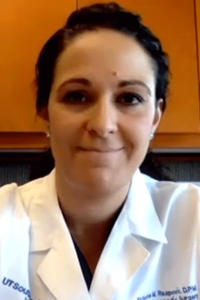
Management of the diabetic foot infection osteomyelitis is a daunting task. While many treatment algorithms exist, there’s no one-size-fits-all protocol, according to Crystal Holmes, DPM, CWSP, Associate Professor at the Michigan Medicine Podiatry Clinic.
Dr. Holmes moderated the Scientific Sessions symposium Dilemmas in Diabetic Foot Infection Management, which can be viewed by registered meeting attendees at ADA2020.org through September 10, 2020. If you haven’t registered for the Virtual 80th Scientific Sessions, register today to access all of the valuable meeting content.
Osteomyelitis occurs in about 20% to 60% of patients with diabetic foot and increases the risk of foot amputation, said Katherine M. Raspovic, DPM, FACFAS, Assistant Professor in the Department of Orthopaedic Surgery at UT Southwestern Medical Center. Dr. Raspovic reviewed what to do when bone biopsy—the most widely used and accurate test for diagnosing osteomyelitis—is not an option.
A biopsy may not be possible if the patient is not healthy enough to go to the operating room, when the intervention/biopsy would be more harmful than helpful, or if the patient has had previous surgical intervention, she said. In these cases, it’s important to review the patient’s history, including a history of previous ulcers, previous amputation, and recurrent infection.

Labs are also important. According to a 2019 paper by Lawrence A. Lavery, DPM, MPH, FACFAS, et al, an erythrocyte sedimentation rate greater than 60 mm/h and C-reactive protein greater than 7.9 mg/L indicate a very high likelihood of osteomyelitis in a patient when there is also clinical suspicion.
“These are very important questions we need to ask our patients and pay attention to,” Dr. Raspovic said. “Also, remember probe-to-bone. In another study by Lavery, probe-to-bone findings only slightly increase the probability of osteomyelitis over tossing a coin, but a negative probe-to-bone test strongly argues against the diagnosis of osteomyelitis. For imaging, everyone should have an X-ray. An MRI (magnetic resonance imaging scan) is extremely helpful, and in those situations and where a patient perhaps has Charcot foot or previous injury, white blood cell SPECT/CT (single photon emission computed tomography/computed tomography) may potentially be the better option to evaluate for osteomyelitis.”
Andrew Crisologo, DPM, AACFAS, FACPM, Assistant Professor in the Division of Podiatric Surgery at the University of Cincinnati Medical Center, discussed the effects of withholding antibiotics prior to bone biopsy for osteomyelitis.

“While literature is limited, there does appear to be a measured effect of antibiotics on culture accuracy of vertebral/hematogenous osteomyelitis, but currently there’s no data to support this in diabetic foot/non-vertebral/direct extension osteomyelitis,” he said.
The data on fungal diabetic osteomyelitis are also limited, but it is a real condition, according to Qeena C. Woodard, DPM, CWS, Associate Professor in the Department of Podiatric Surgery and Applied Biomechanics at Rosalind Franklin University of Medicine and Science. There aren’t any long-range studies, she noted, but it’s important to look at fungal and yeast cultures taken intraoperatively.
“When we have a patient who has nonhealing surgical wounds or ulceration, let’s make sure we look at our fungal species,” she said. “You have to have that suspicion for the immunocompromised, those with catheters, those who have had repeated hospitalizations, and IV (intravenous) access. Fungal osteomyelitis could be what’s making the healing compromised. You also need to have a team approach. Get to know your pathology department and have them look at it as well. It’s not always a diabetic foot; it can be something beyond that. Hopefully we can get the molecular diversity with the gene sequencing to look at this so we don’t have to amputate, and we can have more limb salvage in our future.”

Tejal N. Gandhi, MD, Associate Professor of Internal Medicine in the Division of Infectious Diseases and Medical Director of the Antimicrobial Stewardship Program at Michigan Medicine, discussed potential complications of long-term IV antibiotic therapy and evidence for the efficacy of oral antibiotic therapy in the management of diabetic foot infections.
In the Oral Versus Intravenous Antibiotics for Bone and Joint Infection (OVIVA) trial, surgical debridement or resection of infection occurred in approximately 80% of patients. Treatment failure rates were similar (13.2% for oral vs. 14.6% for IV antibiotic) at one-year post-therapy, and management with oral therapy was found to be noninferior to IV antibiotic therapy. Patients receiving long-term IV antibiotic therapy experienced more IV catheter complications and longer hospital stays.
“In patients with diabetic foot infections, we should consider oral antibiotic therapy as an effective treatment option especially in patients who undergo surgical debridement or resection,” Dr. Gandhi said. “It’s not unreasonable to give three to six days of IV antibiotics, depending how long someone is in the hospital. And then if they have surgical resection and are clinically improving, they can be discharged on oral antibiotics and have a good outcome.”
[gap]
VIEW THIS PRESENTATION
Already registered?
View this presentation at ADA2020.org
Not yet registered?
Register now to access all presentations from the Virtual 80th Scientific Sessions